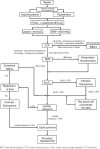How to choose the therapeutic goals to improve tissue perfusion in septic shock
- PMID: 26313438
- PMCID: PMC4943794
- DOI: 10.1590/S1679-45082015RW3148
How to choose the therapeutic goals to improve tissue perfusion in septic shock
Abstract
The early recognition and treatment of severe sepsis and septic shock is the key to a successful outcome. The longer the delay in starting treatment, the worse the prognosis due to persistent tissue hypoperfusion and consequent development and worsening of organ dysfunction. One of the main mechanisms responsible for the development of cellular dysfunction is tissue hypoxia. The adjustments necessary for adequate tissue blood flow and therefore of oxygen supply to metabolic demand according to the assessment of the cardiac index and oxygen extraction rate should be performed during resuscitation period, especially in high complexity patients. New technologies, easily handled at the bedside, and new studies that directly assess the impact of macro-hemodynamic parameter optimization on microcirculation and in the clinical outcome of septic patients, are needed.
O reconhecimento e o tratamento precoce da sepse grave e do choque séptico é a chave para o sucesso terapêutico. Quanto maior o atraso no início do tratamento, pior é o prognóstico, em decorrência da hipoperfusão tecidual persistente, e do consequente desenvolvimento e agravamento das disfunções orgânicas. Um dos principais mecanismos responsáveis pelo desenvolvimento da disfunção celular é a hipóxia. A adequação do fluxo sanguíneo tecidual e, consequentemente, da oferta de oxigênio à demanda metabólica, de acordo com a avaliação do índice cardíaco e da taxa de extração de oxigênio, deve ser realizada durante a ressuscitação, principalmente nos pacientes de alta complexidade. Novas tecnologias, de fácil manuseio à beira do leito, e novos estudos, que avaliem diretamente o impacto da otimização dos parâmetros macro-hemodinâmicos na microcirculação e no desfecho clínico dos pacientes sépticos, são necessários.
Figures






References
-
- Backer D, Creteur J, Preiser JC, Dubois MJ, Vincent JL. Microvascular blood flow is altered in patients with sepsis. Am J Respir Crit Care Med. 2002;166(1):98–104. - PubMed
-
- Jeger V, Djafarzadeh S, Jakob SM, Takala J. Mitochondrial function in sepsis. Eur J Clin Invest. 2013;43(5):532–542. Review. - PubMed
-
- Rady MY, Rivers EP, Nowak RM. Resuscitation of the critically ill in the ED: responses of blood pressure, heart rate, shock index, central venous oxygen saturation, and lactate. Am J Emerg Med. 1996;14(2):218–225. - PubMed
-
- Vincent JL. Determination of oxygen delivery and consumption versus cardiac index and oxygen extraction ratio. Crit Care Clin. 1996;12(4):995–1006. Review. - PubMed
-
- Dellinger RP, Levy MM, Rhodes A, Annane D, Gerlach H, Opal SM, Sevransky JE, Sprung CL, Douglas IS, Jaeschke R, Osborn TM, Nunnally ME, Townsend SR, Reinhart K, Kleinpell RM, Angus DC, Deutschman CS, Machado FR, Rubenfeld GD, Webb S, Beale RJ, Vincent JL, Moreno R, Surviving Sepsis Campaign Guidelines Committee including The Pediatric Subgroup Surviving Sepsis Campaign: international guidelines for management of severe sepsis and septic shock, 2012. Intensive Care Med. 2013;39(2):165–228. - PMC - PubMed
Publication types
MeSH terms
Substances
LinkOut - more resources
Full Text Sources
Medical

